Part 2 of Fahas analysis in the leadup to this weeks assembly election covering the greater Belfast area. I have some caveats regarding the North Down constituency but I’ll leave it to yourselves to comment. BD
This is my analysis of the 9 Belfast area constituencies. The electoral office released the final electoral register on April 28 and there has been an increase of 14,000 voters since December. Over 10,500 of that increase has occurred since March. It appears that approximately 3,000 of those new voters are foreign nationals and 11,000 are native voters. The average per constituency is 777 and the largest increases have been in South Belfast (1,259), Upper Bann (1,203), West Belfast (1,092) and Newry&Armagh (1,005).
North Down
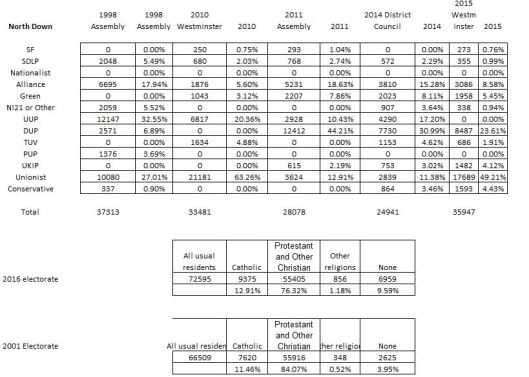
North Down has always been an unpredictable constituency. The 2015 Westminster election provides no guidance to the Assembly results since independent MP Sylvia Hermon received half the vote. In 2011 there were 3 DUP candidates elected but this will change in 2016. The 2014 Council elections provide a more accurate indication for 2016. In that election the DUP received 31% which is 2.4% above 2 quotas. It would require perfect balancing and significant transfers to elect 3 this time. The UUP received 17.2% in 2014. However, the UUP have Alan Chambers as one of their candidates and in 2011 he received over 6% of the 1st preference vote. Because he is one of the UUP candidates the UUP 1st preference vote could be as high as 23%. The UUP will receive transfers from UKIP, TUV, Conservatives and other parties so will likely elect 2. There will be 2 non unionists elected. Brian Wilson is standing as an independent and will take 1st preference votes from both the Alliance and Green parties. Alliance should still elect 1 but it is not clear whether Brian Wilson will be a threat to the Green seat. It may depend on where the SDLP and SF transfers go to. I included the 1998 Assembly election results to illustrate a point. In 1998 the SDLP had over 2,000 1st preference votes. Based on the 2016 demographics one would expect the 1st preference SDLP and SF vote to be almost 3,000. However this constituency has been ignored by both the SDLP and SF and few voters from the Catholic community vote and of those that do the majority vote Alliance or Green. Contrast this with West Belfast, where even though unionists have only a small chance of winning a seat, they make a serious effort and go all out to win a seat for a unionist candidate.
East Belfast
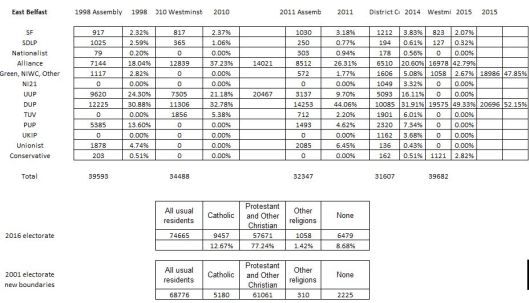
East Belfast is likely to see major changes in 2016 if the same electorate that voted in the 2015 Westminster election vote in the 2016 election. If you look at the results of the 201 Westminster election the total unionist vote was 20,467 and the total non unionist vote was 14,021. In the 2015 Westminster election the total unionist vote increased by only 229 votes to 20,696 but the total non unionist vote increased by almost 5,000 votes to 18,986. Who are those extra 5,000 non unionist voters? We have no way of knowing for certain but it is likely that many are from the Catholic, Other religion and No religion communities since these groups have historically voted at low levels in the past. Some could also be liberal Protestants who voted for the 1st time. The big question for 2016 is will these 5,000 voters vote again this year. If they do then there will be 3 non unionist MLA’s elected. Based on the 2014 Council results there will be 2 DUP and 1 UUP elected. The 2015 Westminster results, with the Alliance vote at 42.8%, predict 3 Alliance seats. However, it is likely that there was a large amount of tactical voting by SDLP, SF, Green and independents for Naomi Long so the 1st preference Alliance vote will certainly by less than 42.8%. The Green party will be in contention for that 3rd non unionist seat. Naomi Long will receive a very high 1st preference vote which may be to the detriment of the 2 other Alliance candidates. If one of those has a low 1st preference vote and is eliminated then the Green candidate could be elected. I include the 1998 Assembly results to illustrate an important point. East Belfast had the highest increase in Catholic population between the 2001 and 2011 census of any constituency. It was 5%. The number of voting age I indicate for 2016 only includes those living in East Belfast in 2011. The 2016 number is probably 11,500 when taking into account the rate at which Catholics have been moving in to East Belfast since 2001. That 11,500 is twice the number that was present in 1998 when the total 1st preference nationalist vote was over 2,000. Theoretically it should be twice that in 2016 at 4,000. However, similar to North Down this constituency has been ignored by SDF and the SDLP. SF only compete in 1 ward, the Short Strand area and the SDLP have ignored the constituency since 1998. After the boundary review East Belfast will be adding wards from South Belfast so it is a poor strategy for both SF and the SDLP to ignore East Belfast since there would be a potential nationalist seat in the new Southeast Belfast.
South Belfast
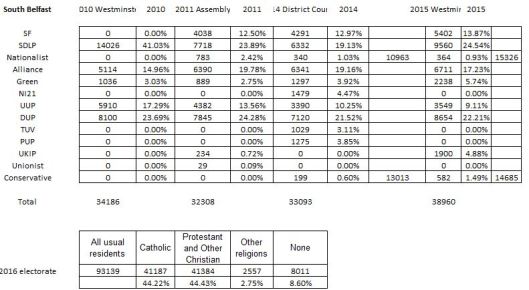
The results in South Belfast will be determined by which electorate shows up on May 5th– the 2014 Council electorate or the 2015 Westminster electorate. If it is the 2014 Council electorate then the SDLP risk losing a seat to either Alliance or the DUP. In the 2015 Westminster election the number of voters increased by 6,000 and almost ¾ were SDLP or SF voters. 2015 also had the highest turnout of any election in South Belfast since the 1998 Assembly election. SF should win their seat here as they need very few transfers. If the SDLP balance their candidates evenly they should elect 2 also since they would receive significant transfers from the Green Party and Alliance surplus. Alliance and Green transfers will go at least 2 to 1 towards a nationalist candidate rather than a unionist. The change in the electorate since 2011 also favour nationalist candidates since the Catholic community electorate has increased by 1,900 while the Protestant community electorate has declined by 900. It will be difficult for unionist candidates to maintain their vote with a declining electorate. On the unionist side the DUP could win 2. The 2015 DUP Westminster vote at 22.1% was over twice the UUP vote of 9.1%. The UUP should pick up enough Conservative, Alliance and Green transfers to be competitive with the DUP. The DUP could still win 2 if the 2 candidates are perfectly balanced and they receive twice as many transfers from the PUP, TUV, UKIP and Ruth Patterson as the UUP do.
West Belfast
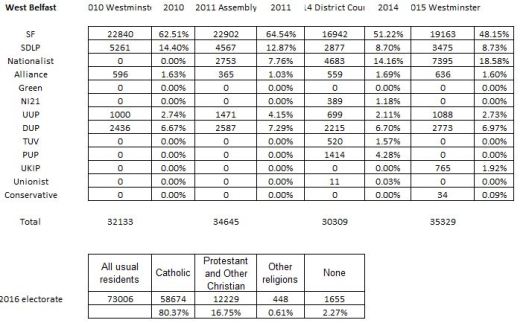
West Belfast will have some major changes compared to 2011. Similar to South Belfast it will be partly determined by which electorate shows up on May 5th, the 2014 Council electorate or the 2015 Westminster electorate. One certainty is that Gerry Carroll of People Before Profit Alliance will be elected as his 19.2% vote in 2015 is far above a quota with a 5% surplus. The SF vote has been in the 54% to 55% range in 2014 and 2015 which is slightly less than 4 quotas. However, they should receive enough transfers from PBP to reach 4 quotas. Nevertheless, they will lose 1 MLA compared to 2011. Theoretically, they could keep 5 with a poor showing by the SDLP and with all 5 of their candidates perfectly balanced at 11%. However, this is unlikely since the SDLP received almost 10% in 2015 and would receive some PBP transfers as well as transfers from Alliance, Green and the UUP. It is also possible that the DUP could win a seat. If the turnout is similar to 2014, when the total unionist vote was 16.0% then the DUP would certainly win. However, in the 2015 election the total vote increased by 5,000 and these were all nationalist voters. In 2015 the total unionist vote was 13.2% which is only 1.1% less than a quota. The last nationalist candidate (probably SDLP) would also be less than a quota. It would have been very close. The one disadvantage the DUP have is Frank McCoubrey may not receive enough UUP transfers due to his previous association with the UDP. In 2011 over 100 UUP transfers went to nationalist candidates and 200 did not transfer. The number that do not transfer could be higher this year.
North Belfast
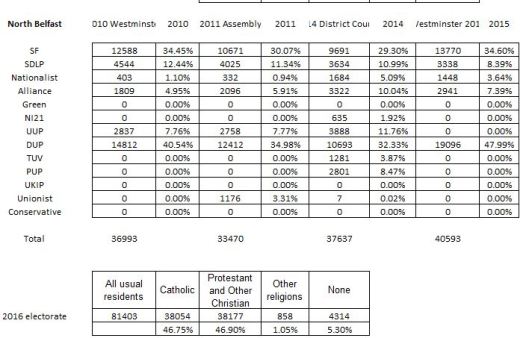
It was thought before the final candidate list was known that the SDLP seat could be under threat from Alliance or a 3rd SF candidate. If you look at the 2014 Council results the SDLP vote was only 1% more than the Alliance vote and SF was less than 2 quotas. However, 2015 was a different result with the total nationalist vote equaling 45.7% which is 2.8% over 3 quotas. Since there are only 2 SF and 1 SDLP candidates by default all 3 will be elected. There is still a scenario where the Alliance candidate could win. The Alliance vote was 7.25% in 2015. If the total nationalist vote were to increase to 47% or more then there would be at least a 4% nationalist surplus. This is possible since there are 1,500 EU nationals on the electoral register who were not eligible to vote for Westminster and if even half those vote for pro EU parties the nationalist vote could reach 47%. Furthermore, since 2011 the Catholic community electorate has increased by 2,400 while the Protestant community electorate has declined by 200. If Alliance receives 3% of the 4% surplus in transfers the Alliance vote would be 10% plus. If the Green and Labour candidates bring out additional voters then those transfers could benefit Alliance also. The 2014 Council vote shows a DUP vote of 28.4% which is 2 quotas so only 2 DUP will be elected. The last seat could come down to Alliance, UUP or PUP. The PUP vote was 7.4% but with TUV and UKIP transfers should be 10%. If the UUP is at or slightly less than 10% then the UUP candidate would be eliminated. If 3% of the UUP transfers go to Alliance, 3% to the PUP and the rest do not transfer then it could be very close between the PUP and Alliance on the last count.
Strangford
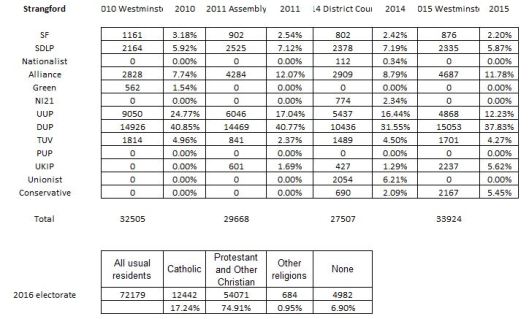
In 2011, the SDLP lost here by only 458 votes. The main obstacle for the SDLP in winning a seat is nationalist voter apathy. Despite a potential electorate over 13,000 the total SDLP and SF vote barely reaches 3,200 with perhaps another 1,000 from the Catholic community voting Alliance. There are 3,500 voters from the Catholic community in Newtownards and Comber DEA’s and the Moneyreagh ward but turnout there is less than 20% and the majority of that 20% vote Alliance. Based on the 2015 vote there should be 3 DUP, 1 UUP and 1 Alliance elected easily with the final seat between the SDLP and either the TUV or UKIP. This constituency is similar to East Derry where basically stay at home nationalist voters are gifting a seat to the TUV or UKIP. There are 11 unionist candidate on the ballot so unionist turnout will probably be as high as it was in 2015. On the other hand UKIP and the TUV have few sources for transfers other than one of these parties to the other so one could be elected with as little as 10% or 11% of the vote on the final count. The Conservatives received over 2,000 votes in 2015 and in the 2014 Council election Conservative transfers were just as common to Alliance as they were to the TUV and UKIP.
Lagan Valley

In the 2014 and 2015 elections Lagan Valley had the 2nd lowest turnout from the Catholic community (only North Down is lower). It was approximately 25% whereas turnout from the Protestant electorate is near 50%. This is at a level that is seen only with an organized election boycott but no one has been able to discover what group is behind the boycott. Lagan Valley also had the 2nd largest increase in the Catholic population between 2001 and 2011 which was 4%. Since many of these people are moving in from West Belfast where nationalist voter turnout is high it is puzzling why the turnout is so low. In view of the in migration I estimate the Catholic electorate is 17,000 and with potential votes from the Other and None communities the potential electorate is 18,000. If even 40% voted there would be a nationalist quota even allowing for more than 1,500 voting Alliance. Based on the 2014 and 2015 elections there will be 3 DUP, 1 UUP and 1 Alliance. The last seat will be down to the last count between the SDLP and either the TUV or UKIP. There are also 1,500 EU nationals on the electoral register and this may be a constituency where EU voters vote at a higher rate than native nationalist voters. The SDLP do seem to be making a serious effort in this election so it could be close for the final seat.
South Antrim
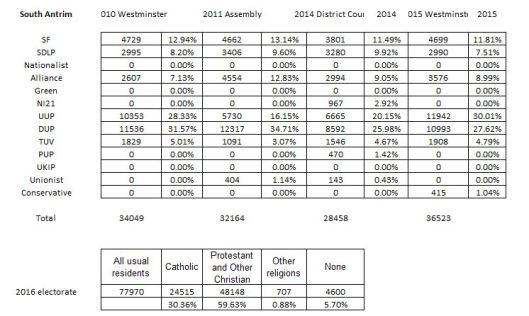
South Antrim is difficult to predict because the Assembly and Council election results are so different than the Westminster results. This is due to tactical voting by Alliance and SDLP voters for the UUP in Westminster elections which was most noticeable in 2015 for Danny Kinahan. This is not the entire explanation since Westminster elections seem to bring out additional unionist voters who do not vote in Assembly and Council elections. In 2011 the SDLP lost on the final count by 1,250 votes. The demographics since 2011 show a net of 1,750 new voters in the Catholic community and 500 in the Protestant community. There was a 4% increase in the Catholic population between 2001 and 2011 indicating significant in migration so the true increase between 2011 and 2016 may be at least 2,500. The DUP and UUP are both standing 3 candidates but the Council results indicate that there are only 2 for the DUP and at most 2 for the UUP. The Alliance vote is always the highest for Assembly elections. The final seat will be between the SDLP and UUP and will depend on whether nationalist turnout increases from its usual low level. There are also 1,500 EU nationals on the electoral register and they will influence the final result.
East Antrim
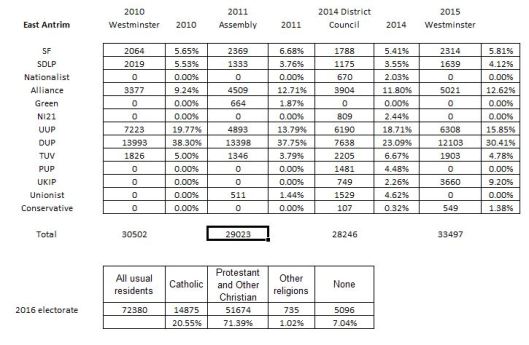
East Antrim is one constituency where SF could lose their seat. It was only by luck that SF won the seat in 2011. In that election at stage 8 Gerardine Mulvenna of Alliance was only 68 votes behind Rodney McCune of the UUP when she was eliminated and 318 of her transfers went to SF and SF won on the last count by 500 votes. However, if the UUP had been eliminated instead the final SF vote would have been only 3,090 and Gerardine Mulvenna would have needed only 700 of the 2,400 UUP transfers available to win. Now East Antrim should elect a nationalist MLA but nationalist turnout is very low here- only 32%. The main reason it is so low is that SF and the SDLP ignore most of the constituency. The 15,000 Catholic electorate is equally divide in 3 areas- 5,000 in the Glens, 5,000 in Larne Town and 5,000 in Carrickfergus and Jordanstown area. The turnout in the Larne Town area extending to Jordanstown is only 20% to 25%. Based on the 2014 Council results there will be 2 DUP, 1 UUP and 1 Alliance elected. One of either UKIP or the TUV will also be elected. The last seat will be between the UUP and SF and will depend on turnout. There is a chance the SDLP could win the final seat. The SDLP were almost 700 votes behind SF in the 2015 election. However, they do not need 700 1st preference votes to overtake SF since if one of the Alliance candidates is eliminated then they would receive approximately 400 Alliance transfers (based on analysis of the 2011 vote). So the SDLP only need to increase their 1st preference vote by at most 400 to win. This is no small task considering the level of nationalist voter apathy.
The 3 most important factors that will determine the final results are
#1 Turnout
#2 Turnout
#3 Turnout
If the turnout is similar to the 2014 and 2015 elections then the number of nationalist MLA’s could decrease from 43 to 40 with a SF loss to a unionist or Alliance in East Antrim and a SDLP loss to the DUP in West Belfast and a SDLP loss to Alliance, Green or a unionist in South Belfast. If turnout from the Catholic community equaled turnout from the Protestant community in all constituencies then there would be 50 to 51 nationalist MLA’s elected. I hesitate to predict any increase in turnout for this election. Unionist voters are reliable when it comes to voting and in looking at the votes for unionist candidates in Westminster and Assembly elections going back as far as 2003 I expect the vote for unionist candidates to be between 340,000 and 370,000. The 319,000 in 2011 was an anomaly due to scandals within the DUP. The vote for nationalist candidates has been in the narrow range of 285,000 to 287,000 since 2010. Since EU nationals can vote in this election and there are 30,000 on the electoral register the nationalist vote should increase to 300,000. It is difficult to identify any issues that would increase turnout further. There has been much publicity in the press about abortion and gay marriage. The latter affects only a very small minority of the electorate and would have minimal influence on turnout. Abortion is an emotional issue and could increase turnout among voters who are either pro life or pro choice. The publicity surrounding the anniversary of the Easter Rising may increase overall interest in politics among nationalist voters but that is probably limited to people who are already voting anyway. It is also possible that Brexit could have a slight influence among nationalist voters who are concerned about the border or economic implications of Brexit.
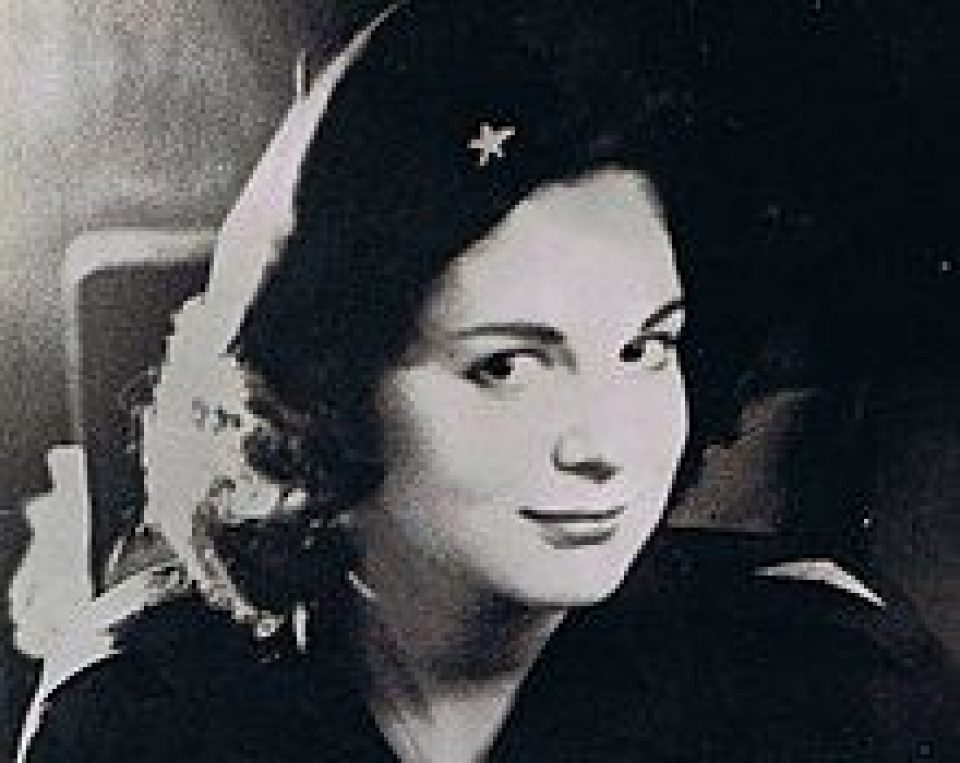
Faha,
Excellent details and good stats (though a couple of the tables seem to have lost their last line).
LikeLike
Re the tables, that was me Sammy, now fixed! BD
LikeLike
ta.
LikeLike
Lots of work gone into this but all the focus is on turnout, assuming catholic = nationalist and protestant=unionist. Increasingly this is not the case.
Census 2011 shows far more catholics in N Down, Ards, Larne and Carrick identify as British compared to Irish. Yet you are asking why these british catholics in Carrick arent turning out for SF or SDLP….
Also lots of focus on EU nationals, with the assumption that they are nationalists just waiting to be encouraged to vote. This is beyond wishful thinking. Also most of the growing no religion group identify as brits but this is also ignored here.
Meanwhile on a positive note people from a “protestant” background are increasingly open to UI in the future and Gerry Carroll canvasing on the shankill. Headcounting wont deliver.
LikeLike
re. “assuming catholic = nationalist and protestant=unionist
I agree it is an assumption which is implicit in the figures – which is difficult to quantify.
LikeLike
Brilliant work as ever Faha.
A few points I would like to make:
Firstly inter-party transfers between SF and SDLP and independent Nationalists too.
What I would like to see is evidence of more voters continuing on down the list of candidates giving a lower preference to other nationalists. Believe that at the end of the day the candidate(s) of your choice would be glad to have someone else singing from the same hymn sheet up at Stormont.
Next look at what options are there to increase participation
such as postal voting or by proxy as examples.
On a previously made point here on this blog about voter registration it isn’t just for the parties to sort out but the responsibility of the individual too. That has to be shared 50-50.
Calls for a centre right Nationalist party I suppose is evidence of a generation gap
between more social-conservative elders and more liberal minded youngsters.
If anything if there is to be another political party contesting for Nationalist votes my opinion is it should not be one that until now has shown no real interest in us. It has to be spontaneous and new not a split off existing parties either.
Perhaps in reality a bit of civic pride like asking a neighbour if they need a lift to the polling station is all that is really needed to get a good turnout.
Well anyway I will be voting on Thursday anyway maybe that is all that matters.
LikeLiked by 1 person
Faha,
re “The 2016 number is probably 11,500 when taking into account the rate at which Catholics have been moving in to East Belfast since 2001. That 11,500 is twice the number that was present in 1998 when the total 1st preference nationalist vote was over 2,000. ”
Why has this movement taken place – and to what parts of EB?
LikeLike
Sammy,
I do not know why it has taken place. Possibly because of more affordable housing?
Also with the end of the Troubles Catholics do not fear intimidation if they move to East Belfast. In these wards it appears to be mainly middle class young Catholic families that are moving in. The change in Catholic population from 2001 to 2011 for these wards was:
2001 2011
Belmont 3.9% 8.6%
Ballyhackamore 11.6% 17.2%
Cherryvalley 8.9% 14.5%
Stormont 8.7% 12.9%
Sydneham 3.8% 9.9%
In all these wards the percentage of younger children is between 20% and 28% Catholic in 2011.
In these wards it appears that the majority of the increase is EU nationals (mainly Polish) but also some native Catholics.
Bloomfield 5.1% 16.1%
Island 5.3% 13.9%
The Mount 3.9% 16.1%
The percentage of children who are Catholic is also between 18% and 23%.
LikeLike
Just from my own experience 3 of my school friends have moved to EB. 2 from SB and 1 from Lisburn. I think the reasons have already been stated, housing is far more affordable than neighbouring SB and also times have changed as the area is far safer for a catholic than it used to be
LikeLike
This is encouraging and should help Sinn Féin get over the line in the next assembly eleciton 2011.
LikeLike
Sorry I mean should help get a SF into the assembly in East Belfast in 2021 (not 2011). But the only draw back is that it could be bad news if those catholics are moving from South Belfast and Lagan Valley for the prospects of nationalist advance in those constituencies.
However its said there is generally a lot of growth in the catholic population in south belfast and lagan valley.
LikeLike
Faha,
Thanks for that (I have now come to expect such detailed answers) .
That is a pretty extraordinary change and one I hadn’t seen mentioned previously. Don’t know the geography that well but seems surprising given the bad publicity surrounding the Short Strand and Orange marches e.g on the 12th.
LikeLike
Excellent analysis.
My usual caveat that its not just about numbers. Its also about the politics, at six county level and parish pump level.
For example in West Belfast, there is a big issue about the closure of day centres by Belfast Trust. PBP and SDLP have been able to protest much more consistently than SF.
Different areas…different people…different issues.
LikeLiked by 1 person
I should add that Mr Fitz is currently publishing some excellent constituency profiles and predictions over at his own site: https://fitzjameshorselooksattheworld.wordpress.com/
LikeLike
Thank you Mr Dub…12 down…6 to go.
LikeLiked by 1 person
Pingback: The Silent Unseen – Extramural Activity
Turnout seemingly around low 50’s. Comparable to 2011. A further dilution for the nationalist vote? 38% or there abouts should see no gains and a few losses…
LikeLike
I think the unionist turnout is down not the nationalist one because on The View they are saying that West of the Bann there is a higher turnout than East of the Bann.
I think SF will get seats in Foyle, U Bann, and perhaps East Derry. But to be honest I think SDLP will struggle to hold in W Belfast and will not pick up in Strangford.
LikeLike
Though the nationalist vote didn’t go up I would say it doesn’t matter much for a United Ireland what happens in terms of the elections in any year, because we know that society is very rapidly changing towards a catholic majority. The Catholic birth rate is higher, the protestant emigration rate (protestants going to English universities and never coming back) is higher, and the protestant death rate is higher. All of these point to the inevitability of a Catholic north, and its coming very fast folks.
I think that Paddy Reilly of Slugger and Enda of Endgame in Ulster have both calculated that there will actually be a Catholic majority in December of this year (December 2016) and Bangordub has calculated that there will be a Catholic majority in the electorate in 2021.
This should be cemented into the Census of 2021 which will be published in 2022.
That indicates that we should be able to win a referendum for a United Ireland in the first few years of the 2020s .
LikeLike
I was quite encouraged by this post on Politics.ie
“Give it two or three election cycles and the nationalist demographic will be more accurately reflected in the polls. Unionism won’t have too many more days like today.”
LikeLike
As someone brought up in the ‘other side’ who votes Alliance, wouldn’t transfer to a DUP (or any of the crowd further to the right of them) candidate if you paid me and couldn’t care about the border I would like to see FG/FF to start competing in elections in NI as a matter of priority. I think the lapse in turnout on Thursday was about as an openly extended invitation from ‘used to be’ nationalist voters as you’re going to get. You have two parties – one who has a clearly defined but increasingly disengaged voter base and the other who don’t really know what their voter base is but whose strategy is to steal voters from the former.
This is not working. It is not good for Nationalism to be completely aligned to left of centre policies and even worse to be relying on demographic change to do the work for it. The Southern parties are needed to seriously shake things up, especially FG who could compete on the centre economically. You don’t need to be a mathematician to understand a United Ireland won’t be the socialist dream SF have banged on about for years. It will be one which occurs only when it could do so with minimum disruption to anyone’s pocket, be they Northern or Southern. Yes, everyone romanticizes about a UI, but we all romanticize about many things. Our romanticism usually evaporates when are confronted with the reality of paying for it.
LikeLiked by 1 person
Ryan you should understand that the New Republic that Sinn Féin are putting forward as the UI it seeks to promote is not based on the right wing economics of the current southern state.
LikeLike
Compulsory voting is what is required. With a none of the above box on the ballot paper for those who dont want to dirty their hands.
LikeLike
Smacks of desperation. If the party’s cannot appeal to the voter to spend 15 mins or whatever to cast a vote for them then their is something wrong with the politics and policy offered. It is not the fault of the electorate.
LikeLike
When the turnout of the various constituencies is compared the ‘Nationalist’ constituencies have a higher turnout that the ‘Unionist’ ones (e.g. West Tyrone 59% versus North Down 49%) – and the Nationalist vote has still gone down- even if you add in the PBP.
So not sure how – lower Nationalist turnout – explains the lower Nationalist vote.
Or am I missing something?
LikeLike
Not to worry Sammy. The Catholic population is growing as horseman pointed out.
LikeLike
Will the PBP MLAs be taking a working mans wage?
LikeLike
Over on Slugger, Paddy O’Reilly has posted these very encouraging demographics, which indicate that a UI referendum could be won in 5 years time.
Year***Protestant**Catholic
2016***865887****857370
2017***863921****865369
2018***861955****873366
2019***859989****881363
2020***858023****889360
2021***856057****897357
2022***854091****905354
LikeLiked by 1 person
Thanks CV,
Do you have a link to that?
LikeLike
Its here (comments)
LikeLike
You’re ignoring the fact that under 18s can’t vote and that’s ignoring the amount of catholics who aren’t fussed. Look, I want a United Ireland but you’re being a tad optimistic to say the least.
LikeLike
BD,
I know we must have covered this before but how do we reconcile the theory of lower turnout by Nats when the constituencies with the highest turnout tend to have a higher % of Nats e.g. ‘Western’ constituencies have a higher turnout than ‘Eastern’ constituencies?
LikeLike
I think in those Western constituencies the protestants (even though there are relatively few) very very much turn out and that increases the turnout there.
There is little to worry about in terms of demographics. The trends seem to be moving very quickly in the direction that will benefit nationalist parties for the 2021 election.
LikeLike
Yes that must as you say be a factor – but it seems a bit unlikely to explain the full difference.
LikeLike
I recall reading posts like that about elections round about now.
LikeLike
Good point Sammy,
I agree with CV to an extent as the “siege mentality” is a central tenet of Unionism. Nevertheless the two main nationalist parties have a serious issue regarding motivating their supporters to come out and vote.
LikeLike
Has anyone seen any estimate of the % of the vote that the PBP got which was ‘Unionist’ in origin?
Just saying you appeal to both ‘sides’ doesn’t mean you actually do…
LikeLiked by 1 person
They are always saying they are happy to get unionist votes and are opposed to the politics of orange and green and make it a badge of honour that they are not nationalist or unionist. Which I have to say they need to be called out on as much as possible in coming years.
LikeLike
Sammy I cant be bothered to add up all the transfers over on wikipedia but of Carrolls surplus around 2300 went to SF/SDLP and a massive 30 yes 30 went to the DUP/UUP – BASICALLY SF transfer more to Unionists than PBP making a bit of a mockery of the designation call
LikeLike
and even then it might be tactical voting – just to keep the Shinners out?
LikeLike
People before Profit need to be called out on that.
LikeLike
I think that Sinn Féin need to call out PBP for the votes PBP are seeking from the Shankill – that could well be a very sectarian vote to keep one of “themuns” out that PBP is picking up. SF should be able to expose and squeeze PBP on the whole question of this.
LikeLike
Don’t be so naive. SF trying to expose ‘this’ would likely be seen as cynical by a constituency that increasingly seems to want to stick the boot into them. They tried to attack Carroll this year after his Westminster showing and his vote rose further. Playing the sectarian card in an overwhelmingly nationalist constituency is a recipe for a spectacular backfire, not dissimilar to Gerry Kelly’s leaflet.
LikeLike
Ryan I think SF do need to remind Catholic voters that PBP are not nationalist and call PBP out on their lack of nationalism.
LikeLike
Reminds me of Unionists calling Alliance out for their lack of Unionism. It won’t help your cause and makes you look desperate if that is the height of your argument.
LikeLike
Hi,
Having been a close reader of this blog, I must commend you Bangordub et al, on a very informative site and interesting read.
As a southern nationalist working in the North, I take a great interest in politics (I also have a northern vote too) .
•In my own opinion, I think this 2016 assembly election has been a watershed for a few reasons. It has cemented a few truths now to the nationalist electorate.
•The nationalist vote has hit the ceiling. It wont have the potential to increase beyond 30 seats.
•The nationalist vote will not succeed the unionist vote. The core nationalist seat number is nearer 40, the core unionist seat number is nearer 70.
•There is no appetite now from nationalists to change the status-quo, ‘you can be Irish now was much as one likes in the North’
•The SDLP and Sinn Fein will never form Pacts like the unionists
•Northern Ireland will remain Unionist for a very very long time. The unionist are under no treat from nationalists. The Nationalist vote is weak.
•Unionist know how to run a good election.
I read a lot about statistics of population changes etc. Although very interesting, it think It serves no purpose for the next 10 years at least. I cant see the point of discussing and calculating sectarian headcounts etc when the electoral system is clearer controlled and of benefit to unionists. Unionists are in the clear majority, and this will be the case for a very long time.
LikeLike
I disagree. The Catholic population is set to be a majority in December of this year. That can only be very significant going forward.
LikeLike
Hi Catholic voter – and what has that got to do with the price of bacon??
Address the points i have made.
So what if the catholic population is the majority. I have yet to see a baby voting.
Its ludicrous to presume all Catholics vote nationalist. Sure nationalists dont even bother to vote.
Unionists have a whopping near 70 seats compared to 40 seats nationalist. Its a pipe dream and somewhat arrogant to think Nationalists will ever succeed unionists.
I have never seen SF as quiet before as in this elections. I think Martin knows apathy among nationalist voters will not be easily moved.
LikeLiked by 1 person
Yeah, if all Catholics think like you yes. But all Catholics don’t. If anything it appears younger Catholics are abandoning the political wagons used by their parents en-masse. Different generation and different experiences will shape their view of things. Innovation is needed within Nationalism. It cannot be a cause reliant on demographic dominance. In a era of mixed workplaces, mixed middle class districts and mixed marriages, that type of politics will cannibalise nationalism in on itself.
LikeLike
Oriel: in addition to the fact that Catholics are set to be a majority this year, Sinn Féin is at an all time high point island wide, and Catholics are set to be a majority of the work force this year or next according to the workforce monitoring link that Croiteir posted below. So politics is working for Sinn Féin and the UI project, and a UI cannot be very far off. I think it is certainly the case that the demographics mean its game on for a UI in just a few short years.
LikeLike
Unionists have near 70 seats? Curious how you work that one out. By my count they have 55. Anyway, my guess is a slow rate of change for about another 15 years as the majority of the older population is still unionist by a decent margin and that’s reflected in the election results. After that, god knows. It’s too hard to predict really. I think demographics will play a bigger role than you think but that it’ll be a slow process and it might just balance out at approx 50/50.
LikeLike
Paddy Reilly has calculated that Catholics are a majority in December this year and I think Bangordub has calculated that they are a majority in the electorate by 2021. So I think you are too pessimistic and that a UI is in sight early next decade.
LikeLike
Oriel27,
Not sure there is currently much point in voting – there is deadlock in Stormo and nothing will be passed unless it suits both sides.
How Nat apathy is interpreted is a reasonable subject for speculation – if the Nat background % goes above 50%. I would imagine it would be of concern to Unionists – and that is in the pipeline – though quite how soon/far away is also a matter for reasonable speculation.
LikeLike
If the SDLP had been one seat short of their present total the pressure on Stormont would be such it might of collapsed. It simply would not have reflected the population. I would say the nationalists have nothing to vote for. They are therefor not voting. If the percentage of nationalists voters drop below 50% Stormont is in dangerous waters.
LikeLike
Thought that this may be of interest
http://www.factcheckni.org/facts/is-the-northern-ireland-workforce-50-50-protestant-catholic/
LikeLike
This is of huge interest in my opinion: http://sluggerotoole.com/2016/05/12/nationalist-turnout-what-it-means-for-sf-the-sdlp/
LikeLike